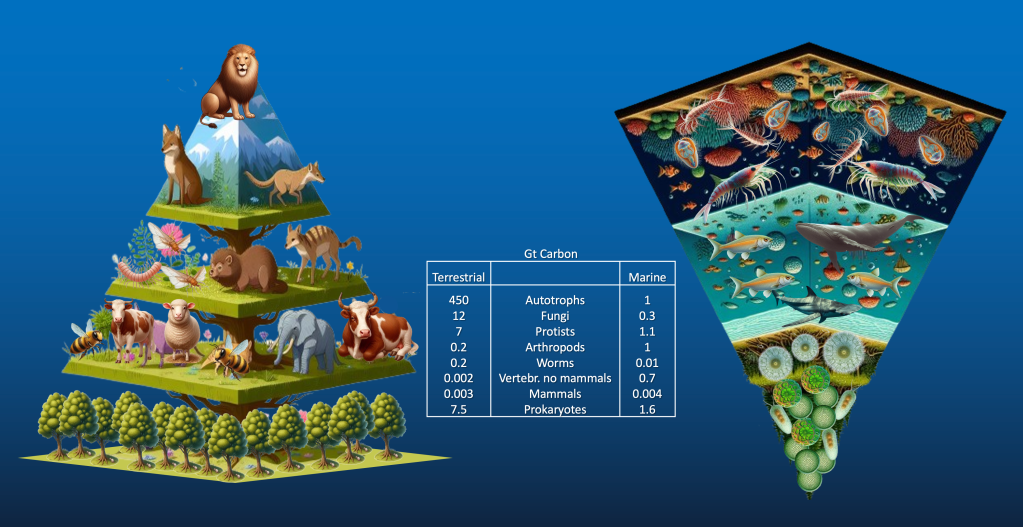The distribution of living organisms on Earth can be quantified using various units, such as the number of individuals or species. However, biologists often utilize a different unit: biomass. Biomass refers to the total mass of living organisms in a given area or ecosystem, encompassing everything from microscopic bacteria to gigantic trees, as well as the organic matter they produce or consume. This unit is particularly useful for understanding the contribution of different groups of organisms to the fluxes of elements, often described in carbon units such as Gt C (Gigatons of carbon = 1,000,000,000,000 kilograms) for global estimates.
Within the different ecosystems on Earth, the biomass pyramid serves as a fundamental representation of energy flow and trophic structure. Comparing the biomass pyramid between marine and terrestrial ecosystems unveils fascinating differences shaped by the unique challenges and opportunities each environment presents. Let’s delve into the depths of marine and terrestrial worlds to uncover the intricacies of their biomass pyramids.
The Classic Pyramid: Terrestrial Biomass Distribution
The terrestrial biomass pyramid, often depicted in textbooks, resembles a pyramid with a broad base and a narrowing apex. This shape reflects the basic principle of energy transfer in ecosystems, known as the 10% rule of thumb. As energy flows through the food chain, approximately 90% is lost as heat at each trophic level due to cellular respiration and other processes. Consequently, the producers, primarily plants, form the vast base of the pyramid, supporting a smaller population of herbivores (consumers) at the next level. These herbivores, in turn, support an even smaller population of carnivores (higher-order consumers) at the top. This progressive decrease in biomass as we move up the food chain results in the characteristic pyramid shape.
However, it is important to note that this is a simplified model, and real-world ecosystems exhibit more complexity. For example, decomposers play a vital role in breaking down dead organic matter and returning nutrients to the system, forming a detritus food chain that runs parallel to the grazing food chain. Additionally, some ecosystems may have multiple trophic levels within each consumer category, further impacting the pyramid shape.
The Marine Biomass Inverted Pyramid
Marine ecosystems present a different picture. Unlike the terrestrial pyramid, the marine biomass pyramid often resembles an inverted pyramid or a diamond shape. This unique structure reflects the significant contribution of microscopic organisms like phytoplankton and bacteria to the total biomass. Despite their small size, primary producers (phytoplankton) form the base of the food chain, supporting a diverse range of zooplankton and other consumers. Phytoplankton may present a very low biomass compared to terrestrial plants (1 vs 450-470 Gt C, respectively), but they boast similar production rates (estimated at around 50 Gt C per year for both), owing to the rapid reproduction and turnover rate of phytoplankton. Thus, while terrestrial plants hold the crown in terms of total mass, marine phytoplankton wear the production power belt, highlighting the diverse and complex nature of life on Earth, where size does not always dictate efficiency.

Data for the table from https://www.encyclopedie-environnement.org/en/life/distribution-biomass-planet/. Albert Calbet, A.I-generated image.
As we move up the food chain, the biomass of consumers increases. Zooplankton, microscopic animals that feed on phytoplankton, have an estimated biomass similar to that of phytoplankton. Further up the food chain, fish (including small fish, forage fish, and larger predatory fish) have an estimated biomass of approximately 0.7 Gt C. This cumulative biomass of predators reflects the accumulation of energy as it moves up the food chain. Large marine mammals, like whales and sharks, sit at the top of the food chain and, despite their impressive size, have a relatively low estimated biomass, approximately 0.004 Gt C. This is because they are apex predators (sharks) with smaller populations and longer lifespans, requiring less food in total compared to the lower trophic levels.
Biomass Distribution Beneath Our Feet
Deep beneath the bustling surface of our planet lies a hidden world teeming with life – a vast biosphere dominated by bacteria and archaea (both included into the prokaryotes). These microscopic marvels, often overlooked and underestimated, hold the title of the most abundant life forms on Earth, residing in staggering numbers not only in our familiar environments but also in the depths of the terrestrial and marine subsurface. Estimates suggest that bacteria and archaea collectively contribute a staggering 30-60 Gt of carbon to Earth’s total biomass, accounting for roughly 70% of the biomass in the deep terrestrial subsurface. This dwarfs the biomass of all animals on our planet, highlighting the sheer scale of this microbial domain. Just for comparison, the combined biomass of bacteria and archaea in surface soil and marine ecosystems accounts for 7.5 and 1.6 Gt C, respectively. The vast biomass of bacteria and archaea in the subsurface plays a crucial role in various biogeochemical cycles, influencing processes like carbon sequestration, nutrient cycling, and methane production. Moreover, the subsurface environment presents a unique set of challenges for life. Sunlight, the primary energy source for most organisms, is absent, forcing bacteria and archaea to rely on alternative energy sources. They can utilize chemical energy from various processes, such as the breakdown of minerals or the oxidation of methane, to fuel their growth and survival. Additionally, the subsurface environment is often devoid of oxygen, necessitating the dominance of anaerobic organisms – those that can thrive in the absence of oxygen. These adaptations allow bacteria and archaea to flourish in this challenging realm, forming the cornerstone of the hidden biosphere.

Albert Calbet, A.I. generated image.
Comparing the shapes of terrestrial and marine biomass pyramids reveals the fascinating diversity of how life organizes itself on Earth. The terrestrial pyramid reflects the principle of diminishing energy as it progresses through the food chain, while the marine pyramid showcases the significant role of microscopic organisms and their fast cycling of matter and energy. Understanding these differences is crucial for appreciating the unique characteristics of each ecosystem and for developing effective conservation strategies to protect the delicate balance of life on our planet.